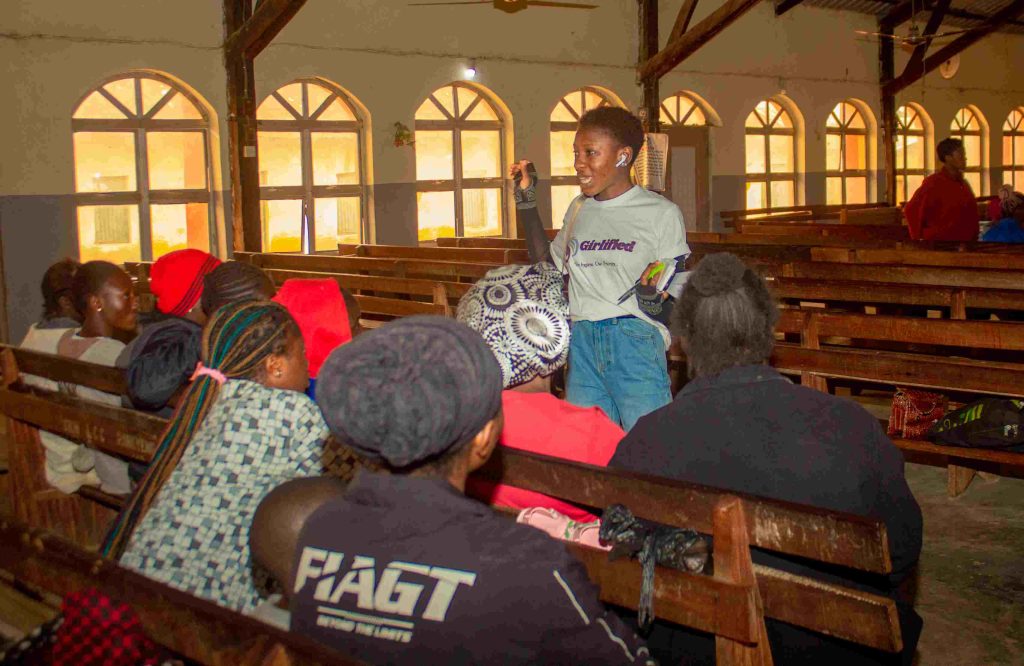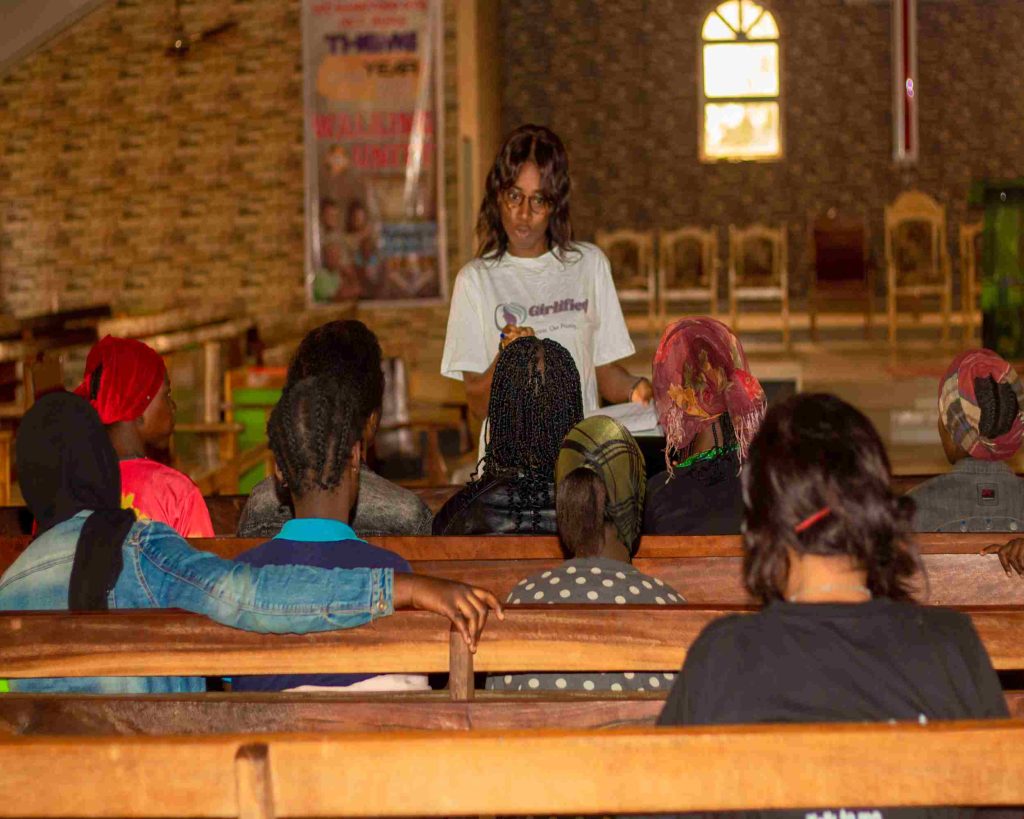GIRLIFIED WOMEN AND GIRLS ENGAGEMENT/FOCUS GROUP DISCUSSION
17th Sept. 2022

It was an hour’s engagement where our co-founder, Oghenekevwe Emadago introduced the Girlified product and talked about our plastic reduction goal and our plan to continue to be in close contact with them-our potential customers. Among the numerous things he spoke about he made a strong quote “plastic pollution is a serious issue that requires quick climate action and you all ladies seated here can join hands to make our fight against it a successful one”. We engaged them on several topics that border around sanitary pad use, their preferences and discomfort.
Below are the reports from the five interviewers:

Nyipoji Kani
I had the opportunity to engage 11 women, 9 of which were teenagers and the other 2 were adults. We discussed the discomfort they have while using sanitary pads and I was able to deduce that the pad material isn’t thick enough to hold a large amount of blood. They experience a peppering feeling whenever they use certain pads and they suffer from tiny rashes. Some mentioned that they do not use pads, instead, they use wrappers which they wash and reuse, causing most of them to suffer infections which alter their period cycle. They all attested to the fact that the price of pads was rising which brought about the use of wrappers for some.
And those who could afford the cheaper type used it though it may be discomforting for them. They mentioned that they would love to have pads that are cheaper and more in number (in a pack). They all answered “No” to the two questions I posed “Do you know that plastic pollution is a problem today and that a conventional pad contains as much as 90% plastic?” And I educated them on what plastic pollution is and some facts and figures surrounding it. One lady mentioned Joyland to be her preferred sanitary pad because of the price. Another mentioned Always, but she had no specific reason. If they could change something about the pad what would it be, I ask them. They said the price should be cheaper, the quality in terms of thickness should be improved, the quantity in terms of pad pieces in a pack should be increased, the color should be changed to either black or brown, and the size of the pad should also be big enough to accommodate the outpour. We randomly discussed how they dispose of sanitary pads and I was able to know that some tie in polythene bags and throw them away into the bush, bury it underground or even burn them. An exceptional reply was that of a teenager who believed that her blood can be used to harm her so she washed the sanitary pad before disposing of it.

Mercy Kevin
They suggested the price below: NGN300 ($0.69) for a pack of 8 pieces or even NGN250 ($0.58) for a pack of 8 pieces and NGN500($1.16) for a pack of 12 pieces. Talking about their preferred sanitary pad brand, 90% of the ladies I spoke to, prefer Always sanitary pad because it has a longer length compared to other brands. On things, they would like to change about sanitary pads the majority of them mentioned thickness (some sanitary pads are very light and cannot be used during a heavy menstrual flow), length and most also stated that pads should be more absorbent.

Kyenret Daluwa
About the discomforts experienced using sanitary pads, one of the ladies complained about Drylove being too short, and some complained about Virony because it does not stick well to the panties. From their responses, I gather that NDK and Drylove do not take some of them throughout the day.
Talking about the price, most of them attested to the fact that price is a major hindrance to them and that they would like the price of a pack of 8 pads to range from NGN 250-300.
On the issue of their sanitary pad preferences, some prefer children’s diapers because it sticks better and lasts longer, others mentioned their love for Trust sanitary pad because of their feelings and NDK because it does not leak. I did a small survey to see which brand ranks highest in terms of usage and also to see which product they have used and are familiar with. When we got to the issue of what they would like to change in sanitary pads, I noted these points: Pads should be thicker, and softer. Manufacturers should include panty liners. Increase the number of pieces per pack. Make it cheaper. Increase the quality and rate of absorption. Increase the length and width and finally, the stickiness should be increased

Mwanret Gar
Discomforts experienced using sanitary pads:One of the ladies complained about a burning sensation after about two hours of using her sanitary pads (Always). About two of them complained about shifting of the pads, which causes staining.
Price issues: Two of the older ladies complained about the prices of pads, stating that during some months, they couldn’t afford pads and would have to use rags and tissues as substitutes. The younger ones (early to mid-teens) stated that they use Joy land pads (3 pieces in a pack) at NGN150 ($0.34), and they believe that the price is okay.
Sanitary pad preferences: A lady preferred Always because of its length, and it’s what she’s used to. A lady likes Virony because of its length (it’s shorter than Always and more comfortable for her). She also uses Molped, sometimes the young girls prefer Joyland because of the price.
What to change in sanitary pads: One lady would like to increase the absorbance of pads because she usually has to double her pads during her periods. Others spoke about length and prices.
Miscellaneous discussions: The ladies disposed of their pads by: Burning, burying, throwing in the public dump ‘bola’, putting it in holes in the blocks of fences, the younger ones feel uncomfortable buying pads when males are around, their periods last for a range of 2-7 days, and the use a single sanitary pad for a range of 2-7 hours.

Idoko Divine
I was assigned to 14 females both women and girls after the brief introduction was given and we had discussions about certain issues they face with pad products. I asked a series of questions and the ladies responded with a lot of answers. They are as follows
Questions:
1) Let’s discuss what discomfort you have been experiencing while using sanitary pads. Quite a number complained about the following;
- Rashes in between their tighs which leads to itching.
- Some pads have specific odors once they put them on between 30 mins to an hour and it gets them uncomfortable because of the smell, especially while they are in public places.
- Peeling of the top layer and scattering of the cotton, sometimes enters into the vagina.
- Pain and injury in between the thighs.
- Shifting of the pad
- The thickness and length of some.
- The rough top layer of some.
- Pains in the vagina.
- Thighs turning red.
2) Is the price of pads a problem for you? If yes what would you expect in terms of price reduction… Yes, the price of pads is a big problem for us.
We would like that the quantity of a certain number of pads in a packet is worth the price. The price of pads should be much more affordable for us to get, it is a pain when we have to go get and after a short period the prices go up and we are left with the choice of using rags to keep ourselves.
3) Do you know about plastic pollution? A few did and others didn’t. One of the ladies explained what plastic pollution was in Hausa. I spoke further about the effects of plastic pollution and how it destroys the environment and makes water bodies a disaster and puts the creatures in it in danger. I furthermore discussed how they can prevent plastic pollution.
4) What is your preference for a sanitary pad and what is your preferred pad brand? (Ask for their opinion and ask one person to say why she likes a particular brand. A few mentioned their preferred brands like Always, NDK, Trust and Joyland. I asked not just one but each what they liked about those brands.
- NDK – it has a good fragrance and it is very comfy when put on.
- Always – sticks to the panty more, and has a smooth top layer for the comfort of the vagina.
- Trust – for someone with heavy flow, it holds the heavy bleed enough not to get stained.
5) If you can change one thing in sanitary pads what would that be? At the beginning of the discussion, someone mentioned how a certain product put a kind of mint in the pads and it gives peppery and painful feelings to her vagina, that is one thing she will like to change. How strong the pad sticks to the panty, how the cotton inside wouldn’t scatter.
We had other discussions like how to properly dispose of the pad after use, and how a biodegradable product was the best idea they have had, stories of embarrassing experiences when on their period in public. At the end of the focused group discussion, we held a final 20 minutes feedback session with 18 ladies who we had given our pads to two weeks before to test out. With these, we got to learn more about how different ladies react to our product and where we can make improvements.
From the whole session, we have discovered that period poverty is indeed a problem for the comfort and menstrual hygiene of a lot of ladies in our region. We can draw up this conclusion since the Rankyeng community, among other communities in our region, is not unique in its below-average income level. For this reason, we are developing Girlified to be able to meet the needs of these ladies while giving them the unique sense of saving our oceans from plastics.

